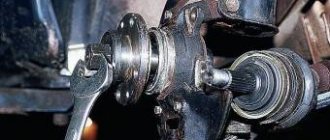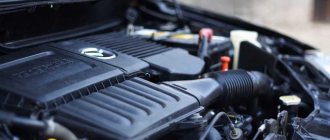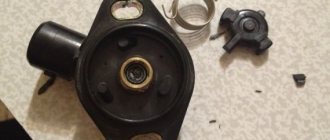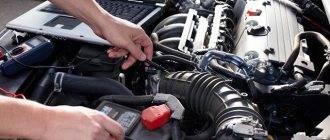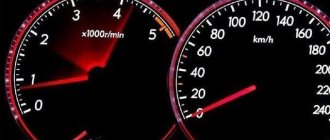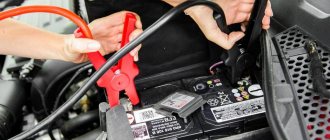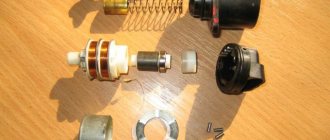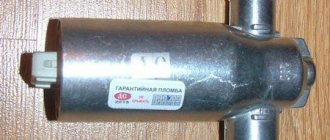- How to find the cause of the problem
- Finding a breakdown without using the on-board controller
- RPM drop in neutral gear
- Sensor malfunction
Compared to the previous carburetor generation, the new injection VAZ 2114 turned out to be much more efficient and reliable, but from time to time they are plagued by various problems. A situation such as a drop in speed after releasing the gas on a VAZ 2114 is almost always caused by problems with the injection system, but other causes must be excluded during the diagnostic process.
VAZ 2114 revs are falling
When releasing the gas, the speed is increased or “freezes”: common malfunctions
Let's start with the fact that on many cars with an injector, the ECU raises the speed while the internal combustion engine is warming up. This is necessary to ensure that the power unit operates stably after a cold start.
However, after the temperature rises, the control unit reduces the idle speed, bringing it to normal. On many cars with a carburetor, the driver independently increases the speed during warm-up, using the so-called “choke”.
Moreover, after the engine is warmed up, the normal idle speed is, on average, 650-950 rpm. If you press the gas and release the accelerator, the speed should increase, and then decrease again to the specified values.
- So, let's start with common carburetor problems. Often the engine speed does not drop due to problems with the throttle valve. For example, when the driver steps on the gas, the throttle must be opened wider to allow more air to enter the cylinders to burn fuel. After the gas pedal is released, the throttle closes and the speed decreases.
If the damper does not close completely, an over-enriched mixture enters the cylinders, and the speed is increased. The cause may be severe contamination of the throttle assembly or damage to the valve itself (deformation). First you need to clean the damper; carburetor cleaning liquid is suitable as a cleaner.
We also note that the damper does not close tightly even when the drive cable is worn out. In this case, the cable must be replaced. On carburetor cars, engine speed often does not drop even if the gasket between the carburetor and the cylinder head has failed. The culprit may also be an intake manifold that is damaged.
The main task is to find the correct ratio of fuel and air. Often, a high level of fuel in the carburetor float chamber also leads to increased speed. The check should begin with the needle valve.
- Now let's move on to the injector. Please note that on many injection cars, after cleaning the throttle valve, the assembly also needs to be additionally “trained”. As for problems, the injection system itself is more complex, that is, there are more reasons for high speeds compared to the carburetor.
In simple words, if the specified sensor gives an incorrect signal, the ECU considers that the engine is cold and activates the warm-up mode. In this case, the control unit raises the speed so that the power unit operates stably and reaches operating temperature faster.
Special attention should be paid to gaskets, since air leaks can lead to disruption of mixture formation. This means that you need to separately inspect manifold gaskets, injector seals, etc.
Let's sum it up
As you can see, in order to accurately determine why the engine speed is not reset, in many cases in-depth diagnostics may be necessary. For carburetor engines, cleaning and adjustment of the carburetor itself is often necessary, while the injector will require computer diagnostics.
If the problem is not on the surface (the throttle cable has become sour, after washing or dry cleaning, the carpet in the cabin is not installed correctly, which presses the gas pedal, etc.), then it is better to take the car to a service center.
The most complex situation is when the design of the power system involves the presence of a large number of sensors and actuators. In this case, even the use of diagnostic equipment does not always allow you to quickly and accurately determine the problem.
Finally, we note that timely detection of a problem allows you to save the life of the internal combustion engine and other components and assemblies. In other words, high idle speeds, floating speeds and jumps indicate that there are problems with the air/fuel supply or with mixture formation. Ignoring such problems negatively affects the engine and its service life.
Why the engine may have high idle speed. The main reasons for high idle speed on an injection engine and engines with a carburetor.
The engine twitches at idle: why does this happen? Engine jerking in idle mode, diagnostics of possible malfunctions, recommendations.
Why does the engine idle unevenly? There are jumps in idle speed. The main causes of unstable idling, diagnostics.
What symptoms indicate that the engine has started to stall: the main signs of engine stalling. Common causes of internal combustion engine tripping, diagnosis, repair.
At idle the speed “floats”: why does this happen? The main malfunctions associated with idle speed on gasoline and diesel engines.
Floating engine idle speed when cold. Basic malfunctions, symptoms and identification of breakdowns. Unstable idling of the diesel engine.
Source: krutimotor.ru
Trouble-shooting
If the idle speed of your VAZ 2114 fluctuates, then the search for causes should be carried out in the following order. First you should check the condition of the spark plugs. Very often they can lead to such a problem. If the spark plugs are oxidized, have carbon deposits or other contaminants, they should be cleaned and engine operation checked. An even more accurate check can be carried out by replacing old spark plugs with new ones.
Difference between new and old candle
It should be remembered that the spark plugs should only be replaced as a set (all 4). It is impossible to replace only one “suspicious” or definitely faulty spark plug; all the others must be replaced as well.
If the spark plugs are in order, then you need to check the integrity of the armor wires and, if broken, replace them. The next step is to check the air filter. If it is heavily soiled or damaged, it should also be replaced with a new one. If after such replacements the motor still does not work stably, then you should proceed to checking the electronic elements.
Broken wiring
Engine speed does not drop at idle: how to fix the problem
It is very important that the engine operates correctly in any mode, including idling. However, many car owners are faced with a problem: when they release the gas, the engine speed does not drop. As soon as such a defect is discovered, it is necessary to immediately find out the cause and eliminate the malfunction for the smooth operation of the car. Also, the engine may slow down for a long time, which also does not contribute to proper operation.
Typically, upon reaching operating temperature, the speed should drop to its normal level. The manufacturer indicates the indicators for each specific vehicle model in the operating manual. They may vary slightly depending on the mileage and general condition of the car, but usually stay within the range of 650-1000 rpm.
In some cases, the speed drops very slowly or even stays at the same level of 1500-2000 revolutions. In this mode, not only does fuel consumption increase, which affects the driver’s finances, but it also contributes to engine wear.
The cause of the idle failure must be diagnosed by qualified technicians. However, you can also understand on your own why the engine speed does not drop.
Why does the VAZ 2114 engine speed not reset?
- To the beginning of the forum
- Forum Rules
- Old design
- FAQ
- Search
- Users
Maybe the throttle valve is just sticking?
Sharp
I myself have this kind of bullshit, it started not long ago and in my opinion it’s IAC. My car's TPS broke down when accelerating, it stalls and jerks, my IAC broke down the same way, I changed it in December and before that I had the same symptoms, it doesn't drop the revs at first sometimes, then at all until you start it again. Well, all this ends with a jump in revolutions from 1000 to 2000 and so you stand stupidly at an intersection, and she revs up (woof, wow, so fast) and everyone looks at you like you’re a moron
Sharp
I myself have this kind of bullshit, it started not long ago and in my opinion it’s IAC. My car's TPS broke down when accelerating, it stalls and jerks, my IAC broke down the same way, I changed it in December and before that I had the same symptoms, it doesn't drop the revs at first sometimes, then at all until you start it again. Well, all this ends with a jump in revolutions from 1000 to 2000 and so you stand stupidly at an intersection, and she revs up (woof, wow, so fast) and everyone looks at you like you’re a moron
And I have this kind of garbage almost every day, and not only does it not reset, but it also increases up to 3000-3500
Somewhere recently there was a thread here, this happens when Carlson is turned on, it is necessary to separate the masses of the ECU and the fan; they have a common brown wire.
And I have this kind of garbage almost every day, and not only does it not reset, but it also increases up to 3000-3500
Somewhere recently there was a thread here, this happens when Carlson is turned on, it is necessary to separate the masses of the ECU and the fan; they have a common brown wire.
I did the topic, and separated the masses, who the fuck knows, maybe he didn’t do it right, although it’s unlikely, so it didn’t help me, I went crazy with these turns, yesterday I spat and made an appointment with a good diagnostician, he said that he would do everything fine, the problem is known, He didn’t say what exactly, tomorrow I’ll see what he does shamanically. Maybe I’ll write back later if I see something interesting.
And I have this kind of garbage almost every day, and not only does it not reset, but it also increases up to 3000-3500
Somewhere recently there was a thread here, this happens when Carlson is turned on, it is necessary to separate the masses of the ECU and the fan; they have a common brown wire.
I did the topic, and separated the masses, who the fuck knows, maybe he didn’t do it right, although it’s unlikely, so it didn’t help me, I went crazy with these turns, yesterday I spat and made an appointment with a good diagnostician, he said that he would do everything fine, the problem is known, He didn’t say what exactly, tomorrow I’ll see what he does shamanically. Maybe I’ll write back later if I see something interesting.
Source
Problems with the carburetor system
When releasing gas, the drop in speed can be bad for both injectors and carburetor systems.
If the car has a carburetor, then there may be several defects.
Most often, the speed does not drop due to a faulty throttle valve. When the engine warms up, it is in the open position to allow more air into the system. Then it closes and the speed should drop.
If the throttle valve is not closed completely, the mixture will still be over-rich when the operating temperature is reached, and the speed will remain at the same level. If this part is heavily soiled or deformed, it cannot close completely.
You can clean the damper using a special product, which can be purchased at an automotive supply store. Deformation may require replacing the carburetor completely. The damper may not close tightly if the drive cable is severely worn. Replacing it may improve the situation.
Another common reason why the engine speed does not drop when idling is the gasket between the carburetor and the cylinder head, which has become unusable, or a damaged intake manifold.
After replacing the carburetor or cleaning the power system, you can often notice that the engine speed is slowly dropping. This occurs due to improper adjustment of the idle system; an over-enriched air-fuel mixture is often supplied. To eliminate the malfunction, it is necessary to adjust the ratio of fuel and air supply to the system.
A high level of fuel in the carburetor float chamber can also cause a malfunction. The needle valve is responsible for it. Checking this detail may correct the situation.
Injector system
If your car has an injection system, there may be many more reasons for high idle speeds. Here, both mechanical elements and electronic devices responsible for adjusting the idle speed can fail.
The main injector malfunctions include:
- Incorrect operation of the temperature sensor installed in the cooling system. Incorrectly received data from this device causes the electronics to recognize the engine as cold and work to warm it up, thereby maintaining high speeds necessary to reach operating temperature. Overheating can often occur, which leads to more serious damage, including major engine repairs. The same effect is possible if the idle speed control is not operating correctly.
- The throttle control cable may become stuck. The higher the mileage of the car, the higher the risk of encountering a similar problem.
- The electronic XX operation sensor often malfunctions, then the speed will either increase or disappear altogether.
- The spring that brings the throttle valve to its original closed position is not functioning properly, is jumping off, or is being stretched too far.
- Too much air enters the fuel combustion chamber due to poor quality or leaky gaskets. It is necessary to carefully check the seals of the manifold and injectors.
- And the simplest reason is usually the incorrect placement of the mat after a visit to a car wash or dry cleaning of the interior. It is often inaccurately placed under the accelerator pedal, which leads to the appearance of improper engine operation.
If the car is oversaturated with various electronics and all the work is based on the correct functioning of the sensors, one of them may well become a problem. It will supply incorrect data to the computer, and as a result, the speed will not drop. You will most likely not be able to detect the problem on your own.
It is necessary to contact a car service for computer diagnostics. The task is best handled by specialists working at a service center that specializes in repairing a specific brand of car. If the diagnosis is carried out on time, then it is quite possible to get away with simply replacing the sensor.
Other reasons
In extremely rare cases, even after repairing and replacing all the sensors listed above, high idle speeds may still remain.
The reason here may lie either in defective devices installed instead of failed ones (unfortunately, this sometimes happens with domestically produced parts) or in the installation of sensors of a model different from the original one.
In the latter case, you should pay attention to the idle speed sensor, since they are produced in two variations - an earlier and a later one (which is installed on 2114).
If, instead, a sensor from an early series was installed, which has an adjusting screw, then it should be fine-tuned by carefully turning the head of the screw and at the same time observing the state of the revolutions.
Floating speed
In addition to slowly falling revs, car enthusiasts may encounter a phenomenon called floating revs, when they drop and then rise sharply. The reason is excessive air supply into the system, which causes the engine to spin up to 2 thousand revolutions at idle.
This often happens in cars that have a fuel injection sensor. It calculates how much air the mixture needs. When its operation is disrupted, different amounts of oxygen are supplied at different times, as a result, speed jumps are observed approximately every 3 seconds.
Faced with a similar phenomenon, the same computer diagnostics will be a prerequisite. It is very important that this and all subsequent work is carried out by experienced, qualified specialists. By contacting a service that does not specialize in breakdowns of this kind, you may be faced with the need to carry out an expensive overhaul of the engine ahead of time.
Source: avtodvigateli.com
Why doesn't the engine speed drop to idle? – Causes and solutions
September 28, 2021 Category: Car fault diagnosis
Often, car owners are faced with such a malfunction when, when releasing the gas, the engine speed does not drop, or more precisely, it does not drop to the normal idle level (idle). This applies to both the fuel injection system and the carburetor.
Typically, the idle speed of gasoline passenger cars, depending on the engine model, is in the range of 650-1000 rpm. Any deviations from these indicators indicate incorrect operation of the vehicle's power system. There is no point in delaying the elimination of this malfunction, since increased engine speeds lead to increased fuel consumption in the car and accelerated engine wear, which negatively affects the driver’s financial condition.
Sometimes the reason may lie in excessive enrichment of the fuel-air mixture supplied to the cylinders. This provokes an increase in speed to a certain level, after which the engine begins to “choke”, thereby reducing the speed to a normal value, after which it rises again. This malfunction causes the “floating speed” effect, but the problem may also lie in other malfunctions of the power system. In addition, do not forget that malfunctions in cases with injection and carburetor engines will be different.
Armored wires
When the speed of the VAZ 2114 fluctuates, it is worth evaluating the armored wires. First, we inspect them for visible damage, such as cracks, kinks, fractures. It is possible to determine interruptions in operation without special instruments; just look under the hood in the dark. If the wire is not working, a spark will be visible on it. You can also check the integrity using a multimeter:
- Turn on ohmmeter mode.
- Remove the wires from the cylinder and ignition coil one by one.
- Connect the tester electrodes to the ends.
Normal indicators depend on the brand of high-voltage wire. They are usually indicated on the braid. Also, the differences between the indicators should not be more than 2-4 kOhm.
If there is a malfunction in these two points, it is possible that there is a missing spark or it is weak, which is why the problem with floating speed arises.
Basic problems with an engine with a carburetor power supply system
- The location of the needle valve, which is responsible for adjusting the gasoline level in the float chamber.
- The throttle valve does not close tightly, which often happens when it is clogged or mechanically damaged. A dirty damper should be cleaned with a special product that can be purchased at an auto parts store. And in case of mechanical damage to this unit, most often, a complete replacement of the carburetor is required.
- Incorrect adjustment of the XX system. This problem often appears after cleaning or replacing the carburetor. To eliminate it, you just need to adjust it, ensuring the optimal ratio of gasoline and air in the fuel-air mixture.
- Consistently high idle speeds may indicate that the throttle valve located in the primary chamber is not tightly closed. This problem occurs due to wear of the throttle valve drive cable or deformation of the valve itself.
- Damage to the intake manifold or wear of the gasket between the cylinder head or carburetor.
In the case of an injection power system, there are much more possible reasons for the increase in idle speed. This is due to the fact that they can be associated both with the failure of mechanical components and with the malfunction of electronic sensors.
The main reasons for high speed
As a rule, high speeds of the VAZ 2114 are caused by one of the following malfunctions:
- the air filter is clogged;
- the gas sensor (throttle position) has failed;
- idle speed sensor is broken;
- The air flow sensor has failed.
In addition to the reasons mentioned above, increased speeds can be caused by simpler things, for example, a broken throttle cable. Such problems can be detected and eliminated during the initial inspection, and therefore we will not dwell on them and will talk about checking and replacing sensors.
Main injector malfunctions
- Coolant temperature sensor malfunction. Interruptions in the operation of this sensor lead to the fact that the engine constantly operates at high speeds, in warm-up mode. At the same time, after the power unit warms up to operating temperature, the electronic control unit does not reset the speed to normal values, since the sensor signals that the engine has not yet warmed up. The same thing happens when the idle air regulator is not functioning properly.
- Throttle adjustment cable stuck. This happens especially often on cars with high mileage.
- Malfunction of the idle regulator or its electronic sensor, in which case the idle speed may increase or disappear altogether.
- Throttle position sensor malfunction.
- Jumping or excessive stretching of the return spring, which should return the damper to its original position.
- Damage to the integrity of gaskets, rubber seals of injectors or the manifold itself. With these problems, excess air from the environment enters the combustion chamber.
The most common reason that the engine speed does not drop to idle when releasing the gas may be careless placement of a mat under the accelerator pedal after visiting a car wash.
How to find the cause of the problem
If the speed of the VAZ 2114 drops, you need to comprehensively diagnose the functioning of the injection system on your car, which can be done in your garage if you have a little experience and appropriate instructions. In this case, those “fourteeners” that were equipped from the factory with a dashboard from the German manufacturer VDO have an important advantage, since it, in comparison with the analogue from Schetmash, is equipped with a self-diagnosis mode.
VDO dashboard for VAZ 2114
To carry out this procedure, you will need to perform a few simple steps:
- After turning off the engine, you need to keep the odometer button pressed for three to five seconds;
- Having turned the engine ignition to the first position, the button must be released;
- arrows should appear on the display, which is a signal of normal operation, then the button must be pressed the first time (displaying the firmware version) and the second time - after this probable errors in the ECU will be shown;
- To reset the error message, you will need to hold the button until a zero appears on the display.
Self-diagnosis of VAZ 2114
After reading the manual, you can find out what errors shown on the screen may be associated with the fact that the speed constantly drops when the gas is released on the VAZ 2114.
So, it could be one of the following situations:
- code 1 – controller error;
- code 14/15 – coolant sensor error;
- code 22/23 – throttle position sensor error;
- code 33/34 – mass air flow sensor error;
- code 42 – faulty ignition;
- code 44 – fuel mixture is lean or too rich.
The owner of a VAZ 2114 should remember a specific feature of the self-diagnosis mode on his car: if there are several errors, the computer sums their codes arithmetically, which can be misleading. This can be indicated by a logical discrepancy between the displayed code and the actual problems.
To be completely sure, you will either need to take the car to a service center and pay for its inspection, or buy a diagnostic scanner yourself, which is not that expensive. Another option is if you have the same VAZ model (fully operational), one by one, remove it from it and install potentially vulnerable sensors on your car, using the method of elimination to find the problem.
Let's sum it up
First of all, a malfunction of the injection and carburetor power systems should begin to be diagnosed by inspecting the throttle valve.
In the case of an injection engine, computer diagnostics will help to accurately determine the malfunction of a specific sensor. To do this, it is best to use the services of a service that specializes in servicing cars of a specific brand.
Remember that timely diagnosis will allow you to eliminate the malfunction without significant costs.
Source: auto-pos.ru
RPM drops slowly
Post edited by Temosha: 02/21/2008 – 21:02
- At work
- Group: Users
- Messages: 22,127
| QUOTE (Temosha @ Feb 21 2008, 19:54) |
| The question is primarily for UP. The check light doesn't come on, the car drives great. WHAT COULD BE. One of my thoughts is that the injectors need to be cleaned. I pour fuel 95 |
- The best car is YOURS.
- Group: Waiting
- Posts: 591
| QUOTE (Yuri Petrovich @ Feb 21 2008, 21:21) |
| As an option TPS, suction. |
- Emigrant
- Group: Donator
- Posts: 25,581
- experienced forum member
- Group: Users
- Messages: 2,472
| QUOTE (Yuri Petrovich @ Feb 21 2008, 22:21) |
| As an option TPS, suction. |
- One of the first
- Group: Users
- Posts: 395
- At work
- Group: Users
- Messages: 22,127
| QUOTE (Temosha @ Feb 21 2008, 19:54) |
| fall slowly and impressively. |
| QUOTE (Fox Mulder @ Feb 22 2008, 09:35) |
| throttle body is clogged |
| QUOTE (Temosha @ Feb 22 2008, 00:58) |
| What are the consequences? |
- One of the first
- Group: Users
- Posts: 395
| QUOTE (Yuri Petrovich @ Feb 22 2008, 13:10) |
| Logic? |
- The best car is YOURS.
- Group: Waiting
- Posts: 591
| QUOTE (Fox Mulder @ Feb 22 2008, 13:24) |
| It will explode in less than a week.. :))) |
Here you go again haha Yuri Petvich, I’m asking seriously
Source: teron.online
VAZ 2114 idle speed fluctuates: causes of malfunction and ways to solve the problem
The five-door hatchback VAZ 2114 is a restyled model of the famous “nine”, which rolled off the assembly line of the car plant from 2003 to 2013. At various times, the manufacturer installed on the car power plants with carburetor or distributed fuel injection (injector) of its own making, and since 2007 the car has been equipped with an electronic engine control system. Note that all these engines have one common and very significant drawback - when they switch to idle mode, their crankshaft speed suddenly begins to “float”.
Idle mode
Idle speed is the operating mode of a car engine with the gear in neutral. It is characterized by minimal engine load and low fuel consumption.
Idle mode is used:
- for delivering motor oil from the engine crankcase to friction units after a long period of parking the vehicle;
- to warm up the power unit in the cold season;
- in cases where turning off the motor is impossible or undesirable.
During normal engine operation, the crankshaft speed is idling at 2000 rpm. gradually decrease to 800, then maintaining at this level. However, it also happens that the power plant, when switching to this mode, operates unstably - it randomly changes the speed in the range of 500–1500 rpm, “chokes” and stalls. This tells us: a failure has occurred in the engine control system, the causes of which must be diagnosed and eliminated as soon as possible.
The movement of the arrow of the device shows the change in the number of engine revolutions
Dirty throttle body
If the idle speed of a VAZ 2114 fluctuates, it is worth assessing the condition of the throttle. To do this, it must be removed from the car. If carbon deposits are found on the walls, it must be cleaned. It also has small channels that can become clogged much more easily and interfere with the normal operation of the unit.
To clean the throttle, use a special cleaner, which can be found in almost every car dealership. You can use carburetor cleaner. If the contamination is too strong, you need to soak the part in a clean container with gasoline and then clean it with a brush.
Causes of malfunction
Among the reasons leading to improper engine operation in idle mode are problems with sensors that transmit information to the electronic control unit . These include sensor malfunctions:
- idle speed controller (IAC);
- mass air flow (MAF);
- crankshaft position (CPCV);
- throttle valve position;
- vehicle speed (VSA).
The appearance of floating crankshaft speeds also causes:
- malfunction of the idle speed solenoid valve;
- dirty air filter and spark plugs;
- damage to high-voltage wires;
- wear of gaskets and plugs at the junction of the intake manifold with the cylinders;
- malfunction of the EGR valve, which regulates exhaust gas emissions.
Mass air flow sensor
After IAC, the air flow sensor should be checked. In addition to problems with idle speed, the following symptoms will be detected: failures when pressing the gas, increased fuel consumption, loss of power. To diagnose the sensor, disconnect the chip from it, while carefully monitoring the operation of the engine. If it breaks down, an emergency operation mode is activated, which already includes average indicators. Therefore, if the engine operation does not change, this indicates a malfunction.
Try treating it with cleaner and putting it back in place. The sensor is sensitive and can malfunction at the slightest contamination.
Methods for eliminating floating engine speeds
When starting to find and eliminate the reasons that cause unstable operation of the engine in idle mode, you first need to check:
- Condition of the air filter and spark plugs. If they become critically dirty, they need to be replaced.
- Integrity of insulation of high-voltage wires. If damage is found, they must be replaced.
It is recommended to make sure that there is no suction at the junction of the intake manifold with the engine cylinders. To do this, with the engine running, you need to sequentially spray all joints at the joints with carburetor cleaner or other flammable liquid. If atmospheric air enters there, the car engine jerks sharply, which is why, if a damaged gasket or plug is detected, the element is replaced.
Checking the tightness of the intake manifold (video guide)
Let's consider the remaining elements of the car, the malfunction of which can affect the smooth operation of the VAZ 2114 engine in idle mode.
Solenoid valve diagnostics
Cars with engines equipped with a carburetor are equipped with idle speed solenoid valves. Devices are checked as follows:
- Disconnect the power cord.
- Start the engine to warm up.
- Connect the wire. If a clear click is not heard, the part must be replaced.
Attention! To fully ensure that the valve is working properly, be sure to clean the nozzle and repeat the test.
Adjusting the idle speed on a carburetor engine (with video)
Note that the main reason for the appearance of floating idle speed in engines of this type is the incorrect operation of the carburetor. The device is adjusted by rotating the fuel quality and quantity screws.
Is the EGR system on the injector working?
"Floating" speed can be caused by jamming of the exhaust gas recirculation (EGR) valve, which is installed in the exhaust manifold. It is necessary to periodically remove dirt from the valve seat and its seat using a carburetor cleaning aerosol, avoiding liquid getting on the sensor diaphragm.
Keep the valve seat clean
Attention! If cleaning the unit does not give a positive result, the device must be replaced.
Is the idle air control valve working correctly?
The IAC is checked by measuring the electrical resistance at the contacts - to diagnose the device you will need a tester (multimeter) set to the “ohmmeter” operating mode. To check the details:
- Let's turn off the ignition.
- Disconnect the connection block.
- Let's measure the resistance on contacts A - B and C - D of the device. The optimal readings of the device vary from 40 to 80 ohms.
- Let's repeat the measurements with contacts B - C and A - D. In this case, the multimeter should show “infinity” or an open circuit.
Any violation of the normal resistance values means a malfunction of the regulator. IAC failure is a common cause of floating engine speed at idle, and if a malfunction is detected, the device must be replaced. Before you begin dismantling the part, you must disconnect the negative wire from the battery. After installation, the new IAC is calibrated - the removed terminal is returned to its place, the ignition is turned on and after 5-10 seconds (there is no need to start the engine).
IAC failure is a common cause of floating engine speeds.
Attention! If the battery is not disconnected before dismantling the device, the electronic control unit will not calibrate the IAC.
Serviceability of the mass air flow sensor
To diagnose the mass air flow sensor, you need to switch the tester operating mode to “voltmeter” (20 V). We check the part by following these steps:
- Let's turn off the engine and turn on the ignition.
- Let's measure the voltage at the connection connector between the contacts of the green and yellow wires. The multimeter reading should be in the range of 0.99 - 1.02 V.
The device can be cleaned by “blowing” with a carburetor cleaning aerosol
Attention! The device can be dismantled and cleaned using a carburetor aerosol, but this does not always help. In the event of a critical component failure, it will have to be replaced.
Video: Checking the mass air flow sensor
Cleanliness of the damper assembly
The throttle valve assembly is diagnosed by visual inspection for contamination. Clean the part with cotton swabs and a toothbrush moistened with a cleaning solution. For ease of work, the device is dismantled. After cleaning, it is recommended to blow out all channels and pipes of the unit with compressed air using a tire inflator.
To clean the part, it must be dismantled
Attention! It is recommended that the channel responsible for removing gases from the crankcase be completely filled with a cleaning solution before purging - the diameter of the element is very small and there is no other way to access it.
Video: How to clean the throttle body
Is it possible to diagnose DPKV and DSA?
A breakdown of the DPKV and DSA (Hall sensor) is indicated by the Check Engine indicator that lights up on the car’s dashboard. Testing these devices is only possible using special instruments (oscilloscopes). You can first check the integrity of the wiring; if it is broken, the damage should be repaired.
- The DPKV sensor is installed on a bracket located in close proximity to the generator drive pulley.
- The DSA is located on the speedometer drive mechanism of the gearbox.
For a more detailed introduction to methods for detecting faults associated with engine malfunction in idle mode, it is recommended to watch the following video.
Throttle valve
If after all the checks and measurements carried out above it was not possible to identify a malfunction, then all that remains is to check the condition of the throttle valve assembly. To do this, the part should be dismantled and then cleaned of dirt using cotton swabs. The cleaned part (or rather, all its pipes and tubules) is blown with compressed air using a compressor.
Cleaning the throttle VAZ 2114
Special attention should be paid to the channel that serves to remove gases from the crankcase. Before starting purging, it should be filled with a cleaning compound and allowed to stand for some time, after which the purging itself should be performed. This is caused by the extremely small diameter of the internal channel, as a result of which other methods of cleaning it are simply not available.
In addition to all of the above breakdowns, a breakdown of the DPKV sensor, as well as the Hall sensor, can also lead to “floating” speed. If they fail, the Check Engine light will light up on the car panel. If such a malfunction occurs, it is best to contact a service center, since special equipment is required to check these sensors.
